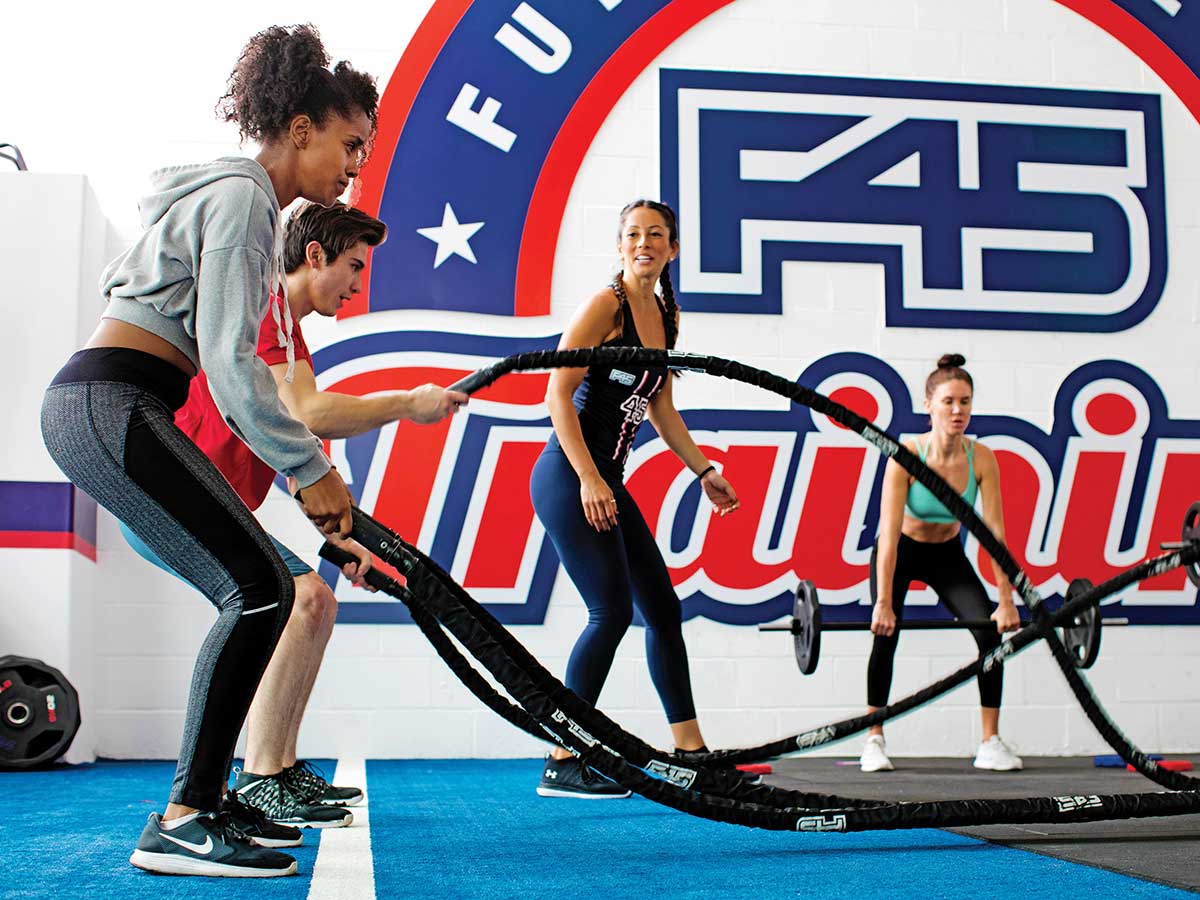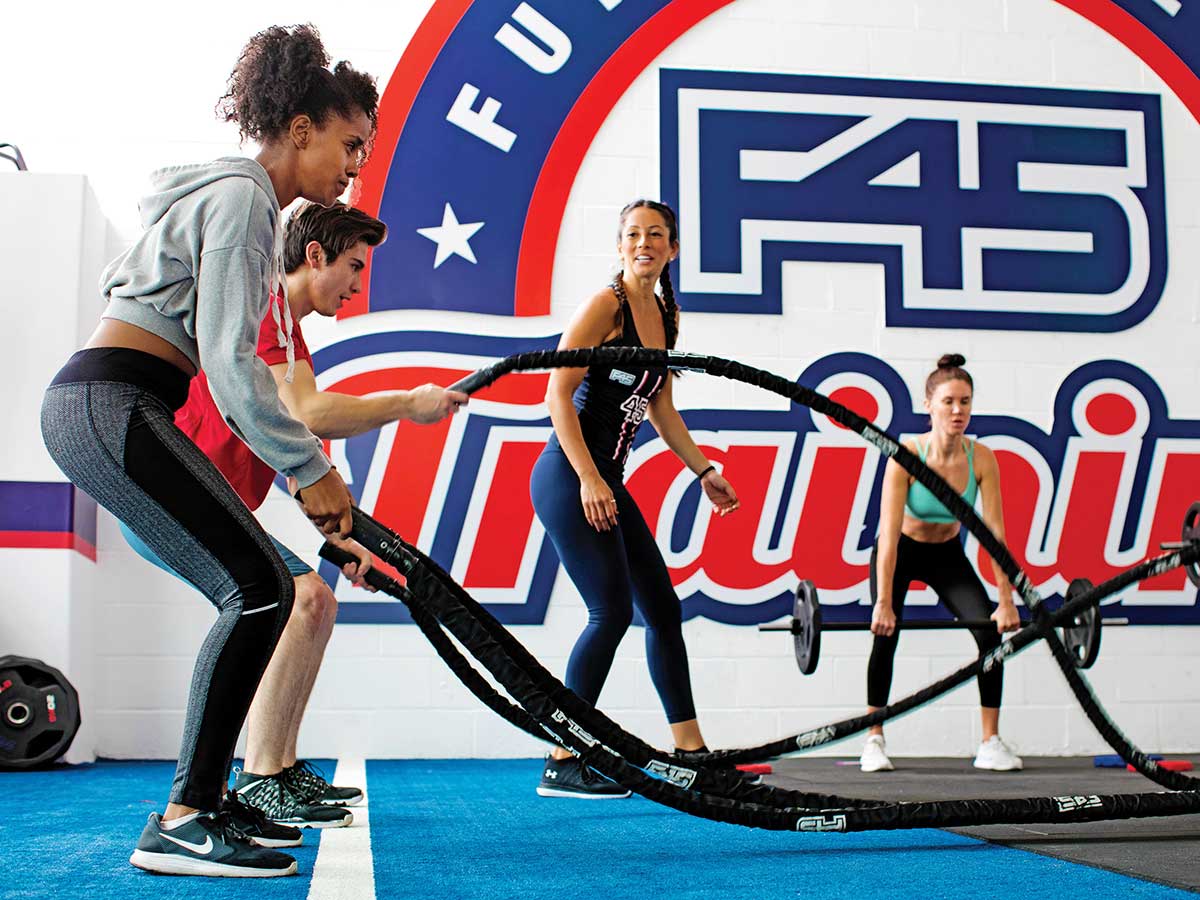
This year’s hottest new workout is fast (and fast-growing)
 Classes at F45 are only 45 minutes long, and because you’re moving quickly, doing reps in intervals at different stations, class moves quickly, too (Photograph courtesy of F45)
Classes at F45 are only 45 minutes long, and because you’re moving quickly, doing reps in intervals at different stations, class moves quickly, too (Photograph courtesy of F45)
After the sweat, the lunges, the medicine ball toss, the vertical push-ups from ankle straps (picture a duck dangling by its feet in the window of a Chinese restaurant; now picture it doing push-ups) and many high-fives, something confusing happened: Everyone at my first F45 fitness class started leaving. “We’re done,” a cheery trainer with tattoos up his calves told me. This was good news, but still, I was surprised. Hadn’t we just started?
Classes at F45 are only 45 minutes long, and because you’re moving quickly, doing reps in intervals at different stations, class moves quickly, too—almost frantically so. This new-model circuit-training workout, rapidly expanding from its Australian roots with 1,500 studios in 43 countries, is a response to two seemingly contradictory realities of our time: We are too busy, and too sedentary. We work long hours—“busy” is a high-currency mantra—and technology allows us to corral and crunch time for efficiency’s sake. But while we click those devices, we are sitting a lot—Canadians spend 69 per cent of their waking hours being sedentary—which can lead to myriad health problems, like weight gain and cancer. Enter F45 with a bittersweet solution: a fast workout for fast times.
F45 belongs to an emerging exercise genre called “functional fitness,” which emphasizes rehabilitative movements that build strength and stamina for daily tasks like snow shovelling and grocery unpacking (think deadlifting sandbags, sitting on a bench and getting up with no hands, swinging kettle bells). At F45, these functional moves get the HIIT—high intensity interval training—treatment, where short intervals of intense exercise are interspersed with static or active recovery. It’s reminiscent of yesterday’s gym-cum-lifestyle phenomenon CrossFit, but the trainers’ careful eyes and safety-first moves (designed in Australia and sent out around the world for a different workout every day) mean there’s less chance of blowing out a knee.
F45 declared a major push into the Canadian market last year, and the flag-like blue-red-and-white F45 logo now hangs over the door of 100-plus franchises from Vancouver to Halifax. It has at least 10,000 active members in Canada and expects that number to double by 2020. Rob Deutsch, the Australian founder and CEO, said via email, “The ultimate goal is to have an F45 studio within 10 to 15 minutes of everyone in Canada.”
“Our target demo is time-strapped 20-to-45 professionals, but we can cater to all fitness levels and ages.”
Paul Smith is helping with that goal. A former CPA, he now runs an F45 franchise in Toronto and two more in London, Ont. When I spoke to him, I mentioned I’d just returned from a class and had almost died. He responded, “But in a good way, right?”
Smith spent a decade in Toronto at BDO and his father’s insurance company, but his dream was always to be an entrepreneur. After a friend returned from an Australian holiday raving about F45, Smith took an intelligence-gathering trip to Sydney. In 2015, he became co-owner of the first Canadian F45 franchise, taking over a former spinning studio in the condo-filled Liberty Village neighbourhood. “People don’t want to waste time figuring out what to do in a big gym. Here, you just show up and get results,” said Smith. “I’d never seen anything like it in Canada—personal training in a group atmosphere that’s super social.” So social that Smith met his wife at F45, and they moved to London to open two more.
The speed-freak workout is mirrored in the company’s rapid-growth business plan. Expanding so quickly means F45 is relying on franchise owners to deliver a consistent experience far from head office, which can be risky, according to Stuart MacDonald, a Toronto-based adviser and investor in early-stage companies: “Any sort of massive scaling efforts puts stresses and strains on the centralized team.” A report from market research firm IBISWorld found that the gym, health and fitness club industry in Canada is booming, with $4.5 billion in revenues and an annual growth rate of 6.8 per cent between 2014 and 2019 (F45 declined to share its revenues). The F45 strategy seems to be blanketing the landscape with its brand as fast as possible, hoping to win a first-mover advantage. But fitness is a crowded, fickle industry. “You put a huge investment into opening all sorts of locations around one concept. What happens if that concept falls out of favour or some other trend comes in?” asks MacDonald. Remember Tae Bo? Sweatin’ to the Oldies?
Research from Canfitpro, Canada’s largest certification organization for fitness professionals, shows that functional fitness is the fastest growing workout trend in Canada, but an F45 class doesn’t exactly feel aimed at older people who might be concerned about snow shovelling injuries. This 40-something was definitely a Gen X outlier, nodding along awkwardly to talk of hangovers and Coachella. It’s not cheap either: a week of unlimited classes at F45 runs between $60 and $68. But research shows that millennials prioritize experiences, including fitness experiences, over acquisition. Their parents might have spent money on a car, while they’ll spend it on the right training session.
“Our target demo is time-strapped 20-to-45 professionals, but we can cater to all fitness levels and ages,” said Smith. “Basically anyone who wants to get results efficiently.” In exercise as in life, our cultural obsession with efficiency may be the common ground between generations. We all feel crunched, and so we all do crunches as quickly as we can—at least until we turn to the next faster, better, hotter workout waiting to hit the marketplace.